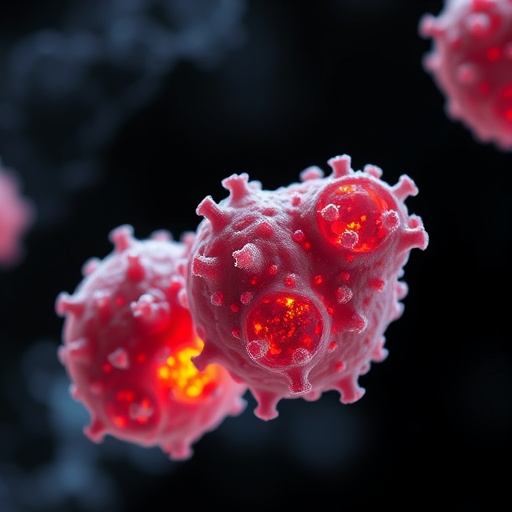In a groundbreaking study published in Acta Parasitologica, a team of researchers has unveiled new insights into calcifying nanoparticles (CNPs) isolated from the outer capsule wall of hepatic hydatid cysts and their intriguing connection with the cellular process of autophagy. This research sheds light on a relatively obscure entity—calcifying nanoparticles—that might hold critical clues to parasitic infection pathology, host immune responses, and potential therapeutic targets for hydatid disease.
Hydatid cysts, caused primarily by the larval stage of Echinococcus granulosus, are a significant global health concern, especially in regions where livestock farming is predominant. These cysts develop in the liver, lungs, and other organs of intermediate hosts, including humans, often causing chronic infections and significant morbidity. The cyst wall is a complex structure composed of parasitic and host-derived components, and the outer capsule wall is an important interface where host-pathogen interactions unfold.
Calcifying nanoparticles have long been a subject of debate in biomedical research. Previously detected in various biological systems, from kidney stones to vascular calcifications, their precise nature, origin, and role have remained elusive. This study is among the first to isolate and culture these nanoparticles directly from infectious hydatid cysts, opening new avenues for understanding their biological significance.
.adsslot_nbwiqZQNYD{ width:728px !important; height:90px !important; }
@media (max-width:1199px) { .adsslot_nbwiqZQNYD{ width:468px !important; height:60px !important; } }
@media (max-width:767px) { .adsslot_nbwiqZQNYD{ width:320px !important; height:50px !important; } }
ADVERTISEMENT
The researchers employed state-of-the-art techniques to isolate CNPs from the outer capsule wall of hepatic hydatid cysts extracted during surgical procedures. Using electron microscopy, they revealed the morphology of these nanoparticles, showing spherical structures with a core-shell configuration composed primarily of mineralized calcium phosphate and organic matrix components. This meticulous characterization distinguishes these particles from inert mineral deposits and suggests an active biological role.
One of the pivotal findings of the study is the link between these calcifying nanoparticles and autophagy—a lysosome-dependent cellular degradation process responsible for recycling damaged organelles and maintaining cellular homeostasis. Through in vitro culture systems, the researchers demonstrated that the presence of CNPs stimulates autophagic activity in surrounding host cells. This suggests that CNPs could influence the host’s cellular response to infection profoundly.
Autophagy has been increasingly recognized not just as a housekeeping mechanism but also as a critical player in host defense and pathogen clearance. By inducing autophagy, calcifying nanoparticles may trigger a double-edged sword: on the one hand, promoting the clearance of parasitic elements and damaged tissues, and on the other, potentially contributing to cyst persistence and chronic inflammation due to sustained autophagic flux.
The experimental approach included co-culturing primary hepatic cells and immune cells with isolated CNPs, observing that autophagy markers such as LC3-II conversion and autophagosome formation increased significantly. Pharmacological inhibition of autophagy reduced the cellular responses to CNP exposure, underscoring a functional relationship rather than a mere association.
Furthermore, proteomic and genomic analyses of cells exposed to CNPs revealed upregulation of genes involved in inflammatory signaling pathways and oxidative stress responses. This finding aligns with the pathological features of chronic hydatid disease, marked by persistent inflammation, fibrosis, and tissue remodeling at the cyst-host interface.
Interestingly, the study also touches upon potential diagnostic and therapeutic avenues. Since calcifying nanoparticles can be uniquely identified by their mineralized matrix and biological signatures, they could serve as biomarkers for early detection of hydatid cyst calcification stages. Moreover, modulating autophagy pathways pharmacologically might offer a novel strategy to control or limit cyst growth and the associated tissue damage.
The broader implications of this research extend beyond parasitology. Calcifying nanoparticles have been detected in several pathological states, including cardiovascular diseases, neurodegeneration, and chronic kidney diseases. Understanding how these particles interact with cellular processes such as autophagy could revolutionize our approach to diverse diseases characterized by aberrant calcification and inflammation.
Notably, this investigation marks a significant milestone in parasitic disease research by integrating nanomaterial biology with host cellular physiology. The intricate dance between calcifying nanoparticles and autophagy opens a new conceptual framework for exploring host responses to chronic parasitic infections, with possible ripple effects in immunology and nanomedicine.
Future research stemming from these findings may explore the molecular mechanisms governing the biogenesis of calcifying nanoparticles within the cyst microenvironment. Questions remain about whether CNP formation is an active parasitic strategy to modulate host immunity or a host defense mechanism aimed at sequestering parasitic components.
Moreover, in vivo models reproducing the dynamics of calcifying nanoparticles and autophagy during hydatid cyst development will be paramount to validate these in vitro observations and to assess therapeutic interventions’ efficacy. The interplay between these nanoparticles and the host immune system’s innate and adaptive arms also warrants deeper exploration.
This study has also reignited discussions about the controversial existence and function of so-called “nanobacteria” or mineral nanoparticles in biological systems. By providing concrete isolation and culture evidence from parasitic tissue, the authors have strengthened the hypothesis that these entities are biologically relevant and not merely artifacts or contaminants.
Clinicians managing hydatid disease may, in the long term, benefit from these insights, as new diagnostic tools based on CNP detection and autophagy modulation therapies could improve patient outcomes and reduce complications related to cyst rupture, infection, or calcification.
In conclusion, the pioneering work by Shi, Niu, Su, and colleagues represents a novel frontier in parasitology and nanobiology by unraveling the enigmatic relationship between calcifying nanoparticles and autophagy within hepatic hydatid cysts. Their findings provide a fertile ground for interdisciplinary research bridging nanoscience, pathology, immunology, and clinical medicine, promising innovative strategies to combat complex parasitic infections and associated chronic diseases.
Subject of Research: Calcifying nanoparticles isolated from hepatic hydatid cyst outer capsule walls and their correlation with autophagy.
Article Title: Characterization of Calcifying Nanoparticles Isolated and Cultured in the Outer Capsule Wall of Hepatic Hydatid Cyst and their Correlation with Autophagy.
Article References:
Shi, H., Niu, S., Su, X. et al. Characterization of Calcifying Nanoparticles Isolated and Cultured in the Outer Capsule Wall of Hepatic Hydatid Cyst and their Correlation with Autophagy. Acta Parasit. 70, 148 (2025). https://doi.org/10.1007/s11686-025-01087-y
Image Credits: AI Generated
Tags: autophagy and parasitic infectionsbiomedical research on calcifying nanoparticlescalcifying nanoparticles in hepatic cystschronic infections from hydatid cystscyst wall structure in hydatid diseaseEchinococcus granulosus pathologyhost-pathogen interactions in cystshydatid disease therapeutic targetsimmune responses to parasitic infectionsisolation of nanoparticles from cystsliver infections from hydatid cystssignificance of calcifying nanoparticles in health






